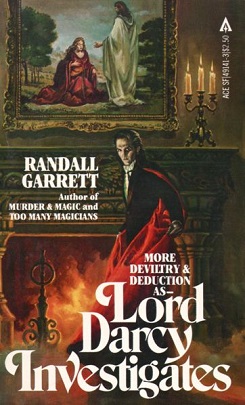
The Number of the Beast is a science fiction novel by American writer Robert A. Heinlein, published in 1980. Excerpts from the novel were serialized in the magazine Omni.

The Schrödinger's Cat Trilogy is a trilogy of novels by American writer Robert Anton Wilson consisting of Schrödinger's Cat: The Universe Next Door (1979), Schrödinger's Cat II: The Trick Top Hat (1980), and Schrödinger's Cat III: The Homing Pigeons (1981), each illustrating a different interpretation of quantum physics. They were collected into an omnibus edition in 1988.

Jesus on Mars is a 1979 science fiction novel by American writer Philip José Farmer, set on Mars and involving an alien civilization. It makes social commentary on a just society and on religious belief.

The Face is a science fiction novel by American writer Jack Vance, the fourth novel in the "Demon Princes" series. It was published in 1979, nearly twelve years after the third.

A Rebel in Time is a 1983 science fiction novel by American writer Harry Harrison.

Lord Darcy Investigates is a collection of short stories by Randall Garrett featuring his alternate history detective Lord Darcy. It was first published in paperback in 1981 by Ace Books, and has been reprinted a number of times since. It was later gathered together with Murder and Magic (1979) and Too Many Magicians into the omnibus collection Lord Darcy.

Transfigurations is a novel by Michael Bishop published in 1979.
Systemic Shock by Dean Ing is the first novel in his Quantrill trilogy and is a science fiction thriller set in the mid-1990s. After the Soviet Union collapses, as a consequence of the events described in General Sir John Hackett's book The Third World War (1978) in August 1985, China and India form a "Sino-Ind" coalition and launch a devastating nuclear attack on America.

A World Between is a science fiction novel by American writer Norman Spinrad, published in 1979.

Electric Forest is a novel by Tanith Lee published in 1979.

Thieves' World is an anthology of short stories edited by Robert Asprin published in 1979, the first in the Thieves' World anthology series.

Web of Everywhere is a science fiction novel by British writer John Brunner, originally published in 1974 by Bantam Books in A Frederik Pohl Selection.

Watchtower is a fantasy novel by American writer Elizabeth A. Lynn published in 1979.

Lifekeeper is a novel by Mike McQuay published in 1980.

The Devil's Game is a novel by Poul Anderson published in 1980.

Beyond Rejection is a novel by Justin Leiber published in 1980.

Octagon is a novel by Fred Saberhagen published in 1981.

Starship & Haiku is a novel by Somtow Sucharitkul published in 1981.
Reefs is a novel by Kevin O'Donnell Jr. published in 1981.
Dale Aycock is an American author of science fiction.

















